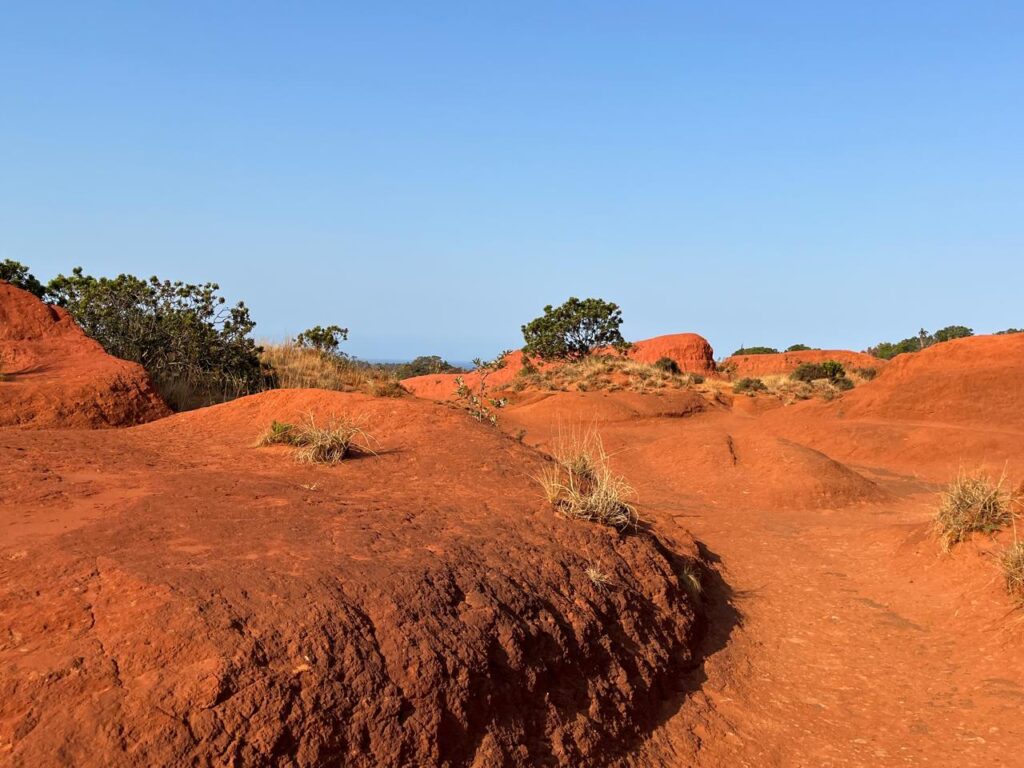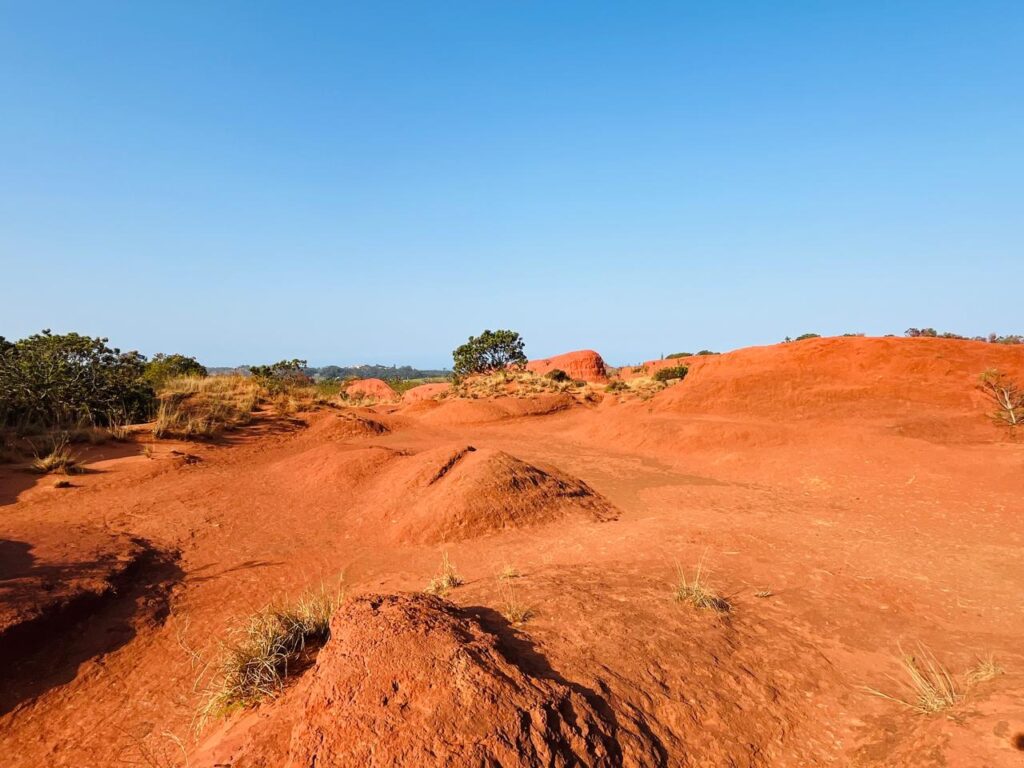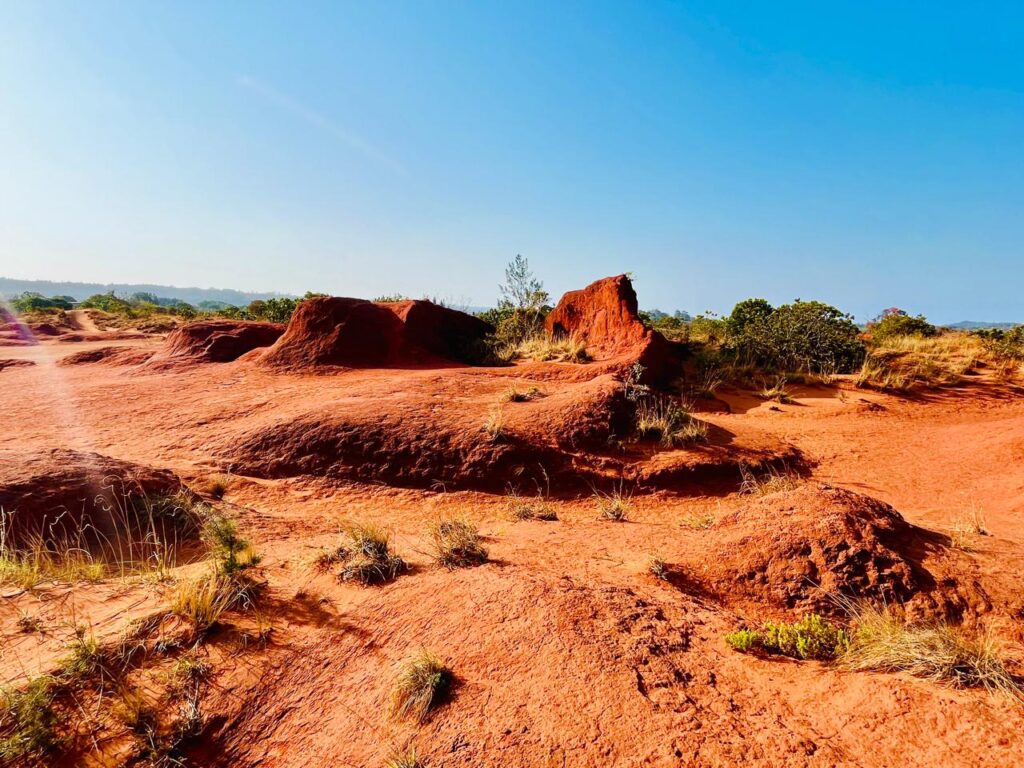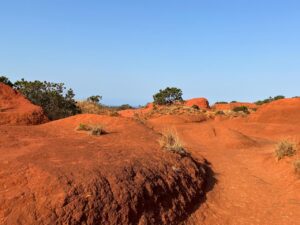

Did you know the KZN South Coast has the worlds smallest desert
The Red Desert Nature Reserve in Port Edward, South Coast, Kwa-Zulu Natal.
Tucked away on the KwaZulu-Natal South Coast of South Africa, approximately ten kilometres west of the coastal town of Port Edward, lies one of the country’s most fascinating natural wonders: the Red Desert. Often described as the “world’s smallest desert”, this extraordinary landscape is a miniature yet striking geological and ecological phenomenon. Although scientists debate whether it truly qualifies as a desert, its uniqueness is beyond question. Crimson sands, wind-carved formations, ancient archaeological treasures, and surprising biodiversity make the Red Desert an unforgettable place.
This article explores the origin, geology, ecology, archaeology, conservation status, and visitor experience of this remarkable site.
- The Red Desert
- 200 metres in diameter,
- Over 200 bird species
The Red Desert, Geological and Geomorphological Features
The Red Desert’s most defining characteristic is its vivid red sand, sculpted into small mounds and ridges by wind and erosion. The striking crimson colour comes from iron oxide that coats the sand grains, a result of long-term weathering of ancient sandstone and dune deposits. These sands are believed to be part of the Berea Formation — a geological unit associated with old coastal dune systems that have been deeply weathered over thousands of years.
The surface of the desert features “yardangs” — narrow ridges carved by wind erosion. These formations indicate that the area has experienced significant aeolian (wind-driven) activity, especially after vegetation was stripped away.
Interestingly, the Red Desert lies in a region that receives high rainfall — around 1,500 millimetres per year — far more than typical deserts. What makes this area “desert-like” is not its lack of rain but rather the inability of vegetation to re-establish itself on the exposed red sands. The iron-rich soil is inhospitable to most plant species, and the lack of moisture retention prevents regrowth.
Several theories attempt to explain how this small red expanse came into being. One view attributes its formation to over-grazing in the 1800s. After local conflicts and cattle raids, large herds grazed the area bare, leaving the soil vulnerable to wind erosion. Another theory suggests that the exposed sands are remnants of ancient natural erosion and dune processes dating back to the Pleistocene epoch. Whatever the case, the Red Desert stands today as a dramatic reminder of both natural and human forces shaping the landscape.
Visiting the Red Desert
Visiting the Red Desert is a unique and rewarding experience that combines geology, ecology, and history. The site offers walking and mountain-biking trails that allow visitors to explore not only the red sands but also the surrounding grasslands and forests. The contrast between the barren crimson dunes and the lush green landscape beyond is breathtaking.
The desert’s sculpted ridges and mounds make for spectacular photography, especially during sunrise and sunset when the colours deepen into shades of scarlet and gold. Birdwatchers and plant enthusiasts can explore the edges of the reserve, where the variety of species is astonishing. For archaeology enthusiasts, spotting ancient stone tools lying on the sand is a thrill — though visitors must remember that removing any artefacts is strictly prohibited.
Practical visitor tips include wearing sturdy shoes, bringing plenty of water and sunscreen, and avoiding the midday heat when the sand reflects intense sunlight. Early morning or late afternoon visits are most comfortable and provide the best light for photography.
Many tourists combine their trip to the Red Desert with nearby attractions such as the Umtamvuna Nature Reserve, the Wild Coast Sun, or the coffee farms and beaches around Port Edward.
The Red Desert, Conservation and Management
The Red Desert and its neighbouring lands have been declared a protected area through a partnership between private landowners and local government. The reserve forms part of KwaZulu-Natal’s Biodiversity Stewardship Programme, which safeguards privately owned land with high conservation value.
This protection is essential. The local vegetation type — the Pondoland-Ugu Sandstone Coastal Sourveld — is classified as critically endangered, with only a small percentage formally conserved. By protecting the Red Desert Nature Reserve, conservationists ensure that this fragile ecosystem and its cultural heritage are preserved for future generations.
Despite the high rainfall, the desert itself remains largely barren due to the iron-rich sands that prevent vegetation from taking root. Rehabilitation efforts are difficult, and experts suggest that restoring the area to its original vegetated state may take centuries.
Visitors to the reserve are asked to respect conservation guidelines: no removal of artefacts, no collection of plants, and minimal disturbance to the delicate environment.
The Red Desert, Facts
- Vegetation target: The site contributes ~1.4% of the provincial target for that vegetation type (though that might sound small, for this particular habitat it is significant).
- The red sands core is roughly 200 m in diameter and about 11 hectares in some descriptions.
- The broader reserve: ~180–210 hectares (variously reported).
- The red sand exposure is said to lie between the Mtamvuna and Izolwane river estuaries.
- It’s a laboratory for erosion, land-use change, human impact and geology: How a small tract of land can change dramatically under grazing + wind erosion is instructive.
- It’s part of a global biodiversity hotspot (Pondoland), meaning the plants and habitats here are rare and globally significant.
- It’s a heritage site: archaeological remains show human presence in deep time — tool manufacture, likely habitation, suggesting the local environment supported early humans.
- It’s also a tourism asset: For a region that is largely coastal beach/tourist oriented, inland features like this help diversify experiences and awareness about conservation.
The Red Desert, FAQ's
Red Desert – Port Edward: Frequently Asked Questions
1. What is the Red Desert?
The Red Desert is a small but striking patch of exposed red sand located about 10 kilometres west of Port Edward on South Africa’s KwaZulu-Natal South Coast. It’s often called “the world’s smallest desert” due to its size and appearance. The red sands form a miniature desert landscape surrounded by lush subtropical vegetation.
2. Why is it called the “world’s smallest desert”?
The Red Desert covers only about 200 metres across (or roughly 11 hectares) of exposed red sand, making it much smaller than typical deserts. Despite its high rainfall, the area remains barren due to its poor, iron-rich soil and erosion history — giving it the look of a tiny desert in the middle of a green landscape.
3. Where exactly is it located?
It’s situated near Port Edward, in southern KwaZulu-Natal, South Africa. The site lies inland between the Mtamvuna and Izolwane rivers, forming part of the Red Desert Nature Reserve, which spans approximately 180–210 hectares.
Directions:
From Port Edward, take the Izingolweni Road, turn onto Old Pont Road, then follow Roy Road and Maurice Road to the entrance and parking area near Eden Crest.
4. How did the Red Desert form?
There are two main theories:
- Human Influence: In the 1800s, large cattle herds grazed the area after conflicts among local tribes. Overgrazing stripped the vegetation, and strong coastal winds eroded the exposed soil, leaving behind the red sand we see today.
- Natural Formation: Some geologists believe the red sands are remnants of ancient coastal dune systems from the Pleistocene period. Over time, natural weathering and iron oxidation gave the sands their distinctive colour.
In reality, both natural and human factors likely contributed to its current appearance.
5. Why is the sand red?
The sand’s vivid crimson colour comes from iron oxide — rust-like minerals coating the grains. These iron-rich sands are part of the Berea Formation, an ancient geological deposit common to South Africa’s coastal regions.
6. Is it a true desert?
Scientifically, no.
The Red Desert is not a “true” desert because it receives about 1,500 millimetres of rainfall annually, which is far too much for desert classification. However, due to the iron-rich, nutrient-poor soil and severe erosion, vegetation struggles to grow — creating a landscape that looks and behaves like a desert.
7. What is the Red Desert Nature Reserve?
The Red Desert Nature Reserve (RDNR) is a protected conservation area established to safeguard the desert core and surrounding habitats. The reserve covers roughly 208 hectares and includes grasslands, coastal forests, wetlands, and cliffs.
It is managed through a public-private partnership under KwaZulu-Natal’s Biodiversity Stewardship Programme, which helps conserve ecologically and culturally important areas on private land.
8. What kind of plants and animals can be found there?
- Despite its “desert” core, the surrounding reserve hosts incredible biodiversity.
- Plants: Over 480 species, including rare and endemic plants from the Pondoland Centre of Endemism, such as Phylica natalensis and several proteas.
- Birds: More than 200 species, including sunbirds, raptors, and forest specialists.
- Animals: Bushbuck, vervet monkeys, mongooses, snakes, and small reptiles inhabit the surrounding vegetation.
- The reserve protects the Pondoland-Ugu Sandstone Coastal Sourveld, a critically endangered vegetation type unique to this region.
9. Are there archaeological findings in the Red Desert?
Yes. The Red Desert is one of KwaZulu-Natal’s richest Stone Age archaeological sites. Tools such as hand axes, scrapers, and flakes dating back hundreds of thousands of years have been discovered here.
Because the sands have been exposed and deflated by wind, artefacts that would normally be buried are visible on the surface — providing valuable insight into the lives of early humans in this region.
10. Are visitors allowed to pick up artefacts or plants?
No.
The Red Desert Nature Reserve is a protected heritage and conservation site. It is illegal to remove artefacts, rocks, plants, or animals. Visitors are encouraged to observe and photograph, but not to disturb or collect anything.
11. What can visitors do at the Red Desert?
Visitors can:
- Walk or cycle along marked trails.
- Photograph the red sands and landscapes.
- Observe birds, wildflowers, and wildlife.
- Learn about local geology and archaeology through guided visits (when available).
Combine their trip with nearby attractions like Umtamvuna Nature Reserve, Beaver Creek Coffee Estate, and Port Edward’s beaches.
12. Are there guided tours?
Guided tours are available on request through local tourism operators or the reserve’s management. However, most visitors explore the site independently. Educational and group tours can be arranged with advance notice.
13. Is there an entrance fee?
Yes.
Visitors are required to pay a small conservation or entrance fee, usually via SnapScan or EFT payment, as part of the reserve’s funding for maintenance and conservation.
14. What facilities are available?
Facilities are limited, as the reserve prioritises conservation. There are no large visitor centres, cafés, or restrooms inside the core area. Visitors should bring their own water, sun protection, and snacks.
15. What should I bring for my visit?
- Comfortable walking shoes or hiking boots.
- Hat, sunscreen, and drinking water.
- Camera or binoculars for birdwatching and photography.
- Respect for nature — leave nothing behind but footprints.
16. When is the best time to visit?
The Red Desert can be visited year-round, but the cooler months (May–September) are more comfortable for walking. Early morning and late afternoon visits are ideal for photography, as the sunlight brings out the deep red hues of the sand.
17. How long does it take to explore the site?
A full visit, including walks around the red sands and adjacent trails, usually takes 1 to 2 hours. Nature enthusiasts or photographers may want to spend more time exploring the surrounding reserve.
18. Is it family-friendly?
Yes. The trails are short and generally safe for children under supervision. Kids often enjoy seeing the “tiny desert” and its unusual red colour. However, there are no playgrounds or formal facilities, so it’s best for families seeking a simple, outdoor adventure.
19. Is it accessible for all visitors?
The terrain around the red sands can be uneven, with soft sand and slopes, so it may not be ideal for wheelchairs or those with limited mobility. There are, however, nearby viewing points accessible by vehicle.
20. Are there any legends or local stories about the Red Desert?
Yes — several!
Local folklore includes stories about:
- Zulu cattle herds overgrazing the land, leading to its barrenness.
- Alien landings or supernatural origins of the red sands.
- Ancient burial grounds or sacred spaces hidden beneath the dunes.
- While these myths are unverified, they contribute to the desert’s air of mystery and charm.
21. Is the Red Desert shrinking or changing?
Locals report that the exposed red sand area may be gradually reducing as vegetation begins to reclaim the edges. However, the process is extremely slow, and the desert-like character remains.
Environmental managers monitor erosion and vegetation changes regularly to track long-term ecological shifts.
22. How is the Red Desert being protected?
The reserve is part of KwaZulu-Natal’s Biodiversity Stewardship Programme, which ensures ongoing conservation, habitat management, and public education. Fencing protects the area from illegal grazing, off-road vehicles, and vandalism.
Ongoing monitoring focuses on protecting endangered plant species, preventing artefact theft, and maintaining sustainable visitor access.
23. Why is the Red Desert important?
The Red Desert is important for multiple reasons:
- Geological significance: A rare, miniature “desert” in a humid region.
- Cultural heritage: A Stone Age archaeological site.
- Ecological value: Home to critically endangered ecosystems.
- Educational role: Demonstrates human impact, erosion, and biodiversity.
- Tourism asset: Adds unique inland diversity to the South Coast’s attractions.
24. Can I camp or picnic there?
Camping and picnicking are not permitted within the desert core to protect its fragile environment. However, there are nearby picnic spots and accommodation options in Port Edward, the Wild Coast Sun area, and the Umtamvuna River valley.
25. Who manages the Red Desert?
The Red Desert Nature Reserve is co-managed by private landowners, conservation NGOs, and the local municipality under the guidance of the KwaZulu-Natal Conservation Authorities. It operates with volunteer and community support for maintenance and education.
26. Can I fly a drone or take aerial photos?
Drone use may be restricted due to conservation rules and the presence of nesting bird species. Visitors should seek permission before flying drones for photography or commercial filming.
27. What nearby attractions can I visit?
- Umtamvuna Nature Reserve: Dramatic cliffs and hiking trails.
- Beaver Creek Coffee Estate: Coffee farm tours and tastings.
- Wild Coast Sun Resort: Casino, golf, and beach activities.
- Port Edward Beach & Estuary: Ideal for swimming, surfing, and fishing.
- Clearwater Trail: Mountain biking and birdwatching routes nearby.
28. Is it worth visiting?
Absolutely.
The Red Desert is one of South Africa’s most unusual and photogenic natural wonders. Its unique geology, archaeological heritage, and surrounding biodiversity make it a must-visit site for nature lovers, photographers, and anyone curious about the hidden gems of KwaZulu-Natal.
Pictures of the The Red Desert




Read more about the Red Desert





